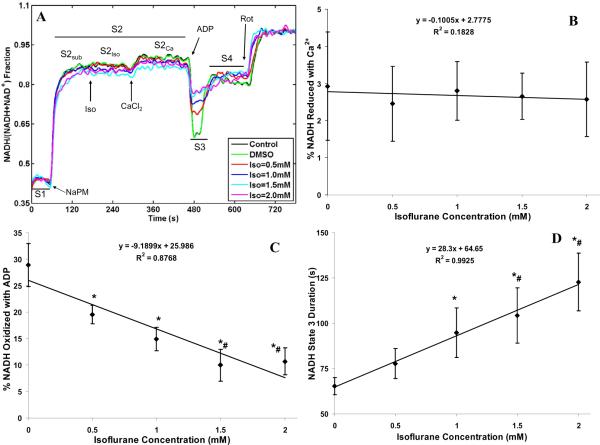Figure 3.
(A) Time-course of mitochondrial redox state (NADH) during states 2, 3 and 4 respiration with isoflurane (0.5, 1, 1.5 and 2 mM) compared to control (no treatment) and vehicle (DMSO) groups. NADH state in each group was normalized on a scale of 0 (fully oxidized with FCCP) to 1 (fully reduced with rotenone) to express NADH state as a % total pool of NAD + NADH. State 2 was subdivided into substrate (S2sub), isoflurane (S2iso), and CaCl2 (S2Ca) effects. Adding ADP (250 μM) caused NADH oxidation (state 3; S3) followed by recovery to state 4 (S4). Traces represent means of 4 replicates in each group. (B, C, D) Summary of effects of 0. 5 mM added CaCl2 (≈200 nM free Ca2+) on state 2 NADH reduction in the presence of isoflurane, of isoflurane+ADP on state 3 NADH oxidation, and of isoflurane on duration of state 3 NADH oxidation; Isoflurane (0.5, 1, 1.5 and 2 mM) effect is compared to the DMSO (Iso = 0 mM) effect. Note that adding CaCl2 caused further NADH reduction for all isoflurane levels (B), ADP transiently oxidized NADH while isoflurane stepwise decreased this level of oxidation (C), and that isoflurane stepwise increased the duration of the state 3 -induced NADH oxidation (D). Data are means ±SE of 4 replicates. * indicates significant differences exist between isoflurane and control/DMSO groups, while # indicates significant differences exist between high and low isoflurane groups (p < 0.05).

